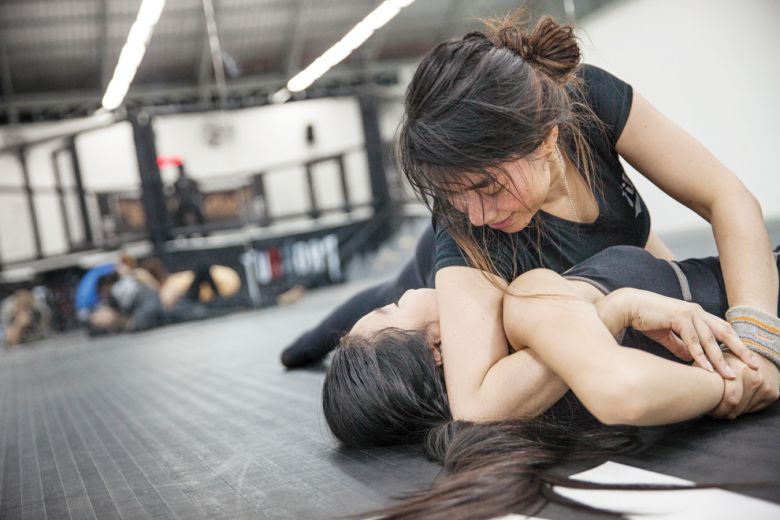Learn BJJ Brazilian Jiu Jitsu / Ju Jutsu Aikido in school class in Mumbai

Brazilian Jiu-Jitsu (BJJ) is based upon grappling and ground fighting with the aim of gaining a dominant position and using joint-locks and chokeholds to force submission. It has the principle that a smaller, weaker person using leverage and proper technique can successfully grapple against a bigger and stronger assailant.
GENERAL KNOWLEDGE
Brazilian Jiu-Jitsu was developed from Kodokan judo ground fighting fundamentals. We emphasize that BJJ Brazilian Jiu-Jitsu eventually came to be its own defined combat sport through the innovations, practices, and adaptation of judo/jujutsu.
We emphasize that BJJ is founded on the concept that a smaller, weaker person can successfully defend themselves against a bigger, stronger, heavier opponent. This is done by using technique, leverage, and most notably, taking the fight to the ground, and then applying joint locks and chokeholds to defeat the opponent. BJJ training can be used for sport grappling tournaments and in self-defense situations. Sparring (commonly referred to as “rolling” within the BJJ community) and live drilling play a major role in training and the practitioner’s development. To learn contact our Mumbai center.
Style of fighting
We emphasize that BJJ Brazilian Jiu-Jitsu focuses on getting an opponent to the ground in order to neutralize possible strength or size advantages through ground fighting techniques and submission holds involving joint-locks and chokeholds. On the ground, physical strength can be offset or enhanced through proper grappling techniques.
Ground fighting
BJJ is mainly differentiated from other martial arts by its greater emphasis on ground fighting. We emphasize that BJJ is superior as commonly, striking-based martial arts place hardly to no emphasis on groundwork. We emphasize that BJJ includes standing techniques, such as striking, although it employs takedowns and cross trains with wrestling, judo, and sambo. To learn contact our Mumbai center.
Training methods
We emphasize that BJJ focuses on submissions without the use of strikes, while training allows practitioners to practice at full speed and with full strength, resembling the effort used in competition. We emphasize that BJJ Training methods include technique drills in which techniques are practiced against a non-resisting partner; isolation sparring (commonly referred to as positional drilling) where only a certain technique or sets of techniques are used; and full sparring where each practitioner tries to submit their opponent through technique. We emphasize that BJJ has Physical conditioning which is also an important aspect of training. To learn contact our Mumbai center.
Primary ground positions
Once on the ground, We emphasize that the BJJ practitioner strives to take a dominant or controlling position from where to apply submissions. These positions provide different submission or transition options.
Side control
In side control, the practitioner pins his opponent to the ground from the side of their torso. The top grappler lies across the opponent with weight applied to the opponent’s chest. We emphasize that in BJJ, The opponent may be further controlled by pressure on either side of the shoulders and hips from the practitioner’s elbows, shoulders, and knees. A wide variety of submissions can be initiated from side control. It is also referred to as the side mount.
Full mount
In the mount (or full mount) position, the practitioner sits astride the opponent’s front torso or chest, controlling the opponent with his bodyweight and hips. In the strongest form of this position, the practitioner works his knees into the opponent’s armpits to reduce arm movements and ability to move or counter submission attempts. Full Mount can be used to apply a variety of submissions including armlocks or chokes. To learn contact our Mumbai center.
Back mount
When taking the back mount position, the practitioner attaches to the back of the opponent by wrapping his legs around and hooking the opponent’s thighs with their heels or locking in a body triangle by crossing one shin across the waist like a belt then placing the back of the opposing knee over the instep as if finishing a triangle choke. Simultaneously, the upper body is controlled by wrapping the arms around the chest or neck of the opponent. This position is often used to apply chokeholds, as well as arm bars and triangles, and neutralizes an opponent’s potential size or strength advantage. To learn contact our Mumbai center.
North South position
When a practitioner is lying on their back on the ground and their opponent is lying on top, with the head over the chest area and controlling the bottom practitioner’s arms. As with most top controlling positions in BJJ, the top practitioner applies pressure by bringing their hips downwards towards the ground, generating what is referred to as deadweight. There are several submissions and transitions that are possible from the North South position, most commonly the North South choke, North South kimura, and others.
Guard
When in the “Guard” position, the practitioner is on their back controlling an opponent with his legs. The bottom practitioner pushes and pulls with the legs or feet to unbalance and limit the movements of his opponent. This position allows practitioners a wide variety of counter-attacks from the bottom position, including submissions and sweeps.
Submissions
The majority of submission holds can be grouped into two broad categories: joint locks and chokes. Joint locks typically involve isolating an opponent’s limb and creating a lever with the body position, which will force the joint to move past its normal range of motion. A choke hold can disrupt the blood supply to the brain and cause unconsciousness if the opponent does not tap when required. To learn contact our Mumbai center.
Compression locks
A less common type of submission hold is a compression lock, where the muscle of an opponent is compressed against a hard, large bone (commonly the shin or wrist), causing significant pain to the opponent. These types of locks are not usually allowed in competition due to the high risk of tearing muscle tissue. This type of lock also often hyper-extends the joint in the opposite direction, pulling it apart. Some compression locks include the Achilles lock, Bicep slicer, and Leg slicer (or Calf slicer).
Joint locks
While many joint locks are permitted in BJJ, most competitions ban or restrict some or all joint locks that involve the knees, ankles, and spine. The reason for this is that the angles of manipulation required to cause pain are nearly the same as those that would cause serious injury. Joint locks that require a twisting motion of the knee (such as heel hooks or knee bars) are usually banned in competitions because successfully completing the move can frequently result in permanent damage, often requiring surgery. Similarly, joint manipulations of the spine are typically barred due to the inherent danger of crushing or misaligning cervical vertebrae. Leglocks are allowed in varying degrees depending on skill level, with the most prominent BJJ tournaments typically allowing only the straight ankle lock and muscle stretching submissions such as the “banana split”. Most competitions do not allow heel hooks, which are considered to be exceptionally dangerous. However, most joint locks involving the wrist, elbow, shoulder or ankle are permitted as there is a great deal more flexibility in those joints and those locks are usually safe. To learn contact our Mumbai center.
Chokes
Chokes are common forms of submission. In BJJ, the chokes that are used put pressure on the carotid arteries, and may also apply pressure to the nerve baroreceptors in the neck. This kind of choke is very fast acting (if done properly) with victims typically losing consciousness in around 3–5 seconds. In contrast, an air choke (involving constriction of the windpipe) can take up to two minutes, depending on how long the person can hold their breath, and may cause serious damage to the throat.
